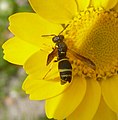ファイル:Odynerus spinipes^ Vespidae. See parasite note - Flickr - gailhampshire.jpg
表示

このプレビューのサイズ: 519 × 600 ピクセル。 その他の解像度: 208 × 240 ピクセル | 415 × 480 ピクセル | 654 × 756 ピクセル。
元のファイル (654 × 756 ピクセル、ファイルサイズ: 166キロバイト、MIME タイプ: image/jpeg)
ファイルの履歴
過去の版のファイルを表示するには、その版の日時をクリックしてください。
| 日付と時刻 | サムネイル | 寸法 | 利用者 | コメント | |
|---|---|---|---|---|---|
| 現在の版 | 2017年10月14日 (土) 13:21 |  | 654 × 756 (166キロバイト) | Chiswick Chap | Cropped 31 % horizontally and 22 % vertically using CropTool with precise mode. |
| 2016年7月8日 (金) 21:48 |  | 952 × 972 (183キロバイト) | Josve05a | == {{int:filedesc}} == {{Information |Description=Most Strepsiptera (also known as twisted-wing parasites) live as internal parasites of bees, wasps, grasshoppers, leafhoppers, and other members of the order Hemiptera. Only a few species that parasit... |
ファイルの使用状況
以下のページがこのファイルを使用しています:
グローバルなファイル使用状況
以下に挙げる他のウィキがこの画像を使っています:
- en-two.iwiki.icu での使用状況
- fa.wikipedia.org での使用状況
- gl.wikipedia.org での使用状況
- la.wikipedia.org での使用状況
- tr.wikipedia.org での使用状況
